In Situ Formation of Titanium Diboride/Magnesium Titanate Composites by Magnesiothermic-Based Combustion Synthesis
Abstract
:1. Introduction
2. Materials and Methods
3. Results and Discussion
3.1. Combustion Exothermicity Analysis
3.2. Self-Propagating Combustion Wave Kinetics
3.3. Phase Composition and Microstructure of Synthesized Products
4. Conclusions
Author Contributions
Funding
Data Availability Statement
Conflicts of Interest
References
- Binner, J.; Porter, M.; Baker, B.; Zou, J.; Venkatachalam, V.; Diaz, V.R.; D’Angio, A.; Ramanujam, P.; Zhang, T.; Murthy, T.S.R.C. Selection, processing, properties and applications of ultra-high temperature ceramic matrix composites, UHTCMCs—A review. Int. Mater. Rev. 2020, 65, 389–444. [Google Scholar] [CrossRef]
- Yurkov, A. Silicon carbide–silicon nitride refractory materials: Part 1 materials science and processing. Processes 2023, 11, 2134. [Google Scholar] [CrossRef]
- Golla, B.R.; Mukhopadhyay, A.; Basu, B.; Thimmappa, S.K. Review on ultra-high temperature boride ceramics. Prog. Mater. Sci. 2020, 111, 100651. [Google Scholar] [CrossRef]
- Basu, B.; Raju, G.B.; Suri, A.K. Processing and properties of monolithic TiB2 based materials. Int. Mater. Rev. 2006, 51, 352–374. [Google Scholar] [CrossRef]
- Königshofer, R.; Fürnsinn, S.; Steinkellner, P.; Lengauer, W.; Haas, R.; Rabitsch, K.; Scheerer, M. Solid-state properties of hot-pressed TiB2 ceramics. Int. J. Refract. Met. Hard Mater. 2005, 23, 350–357. [Google Scholar] [CrossRef]
- Parlakyigit, A.S.; Ergun, C. A facile synthesis method for in situ composites of TiB2/B4C and ZrB2/B4C. J. Aust. Ceram. Soc. 2022, 58, 411–420. [Google Scholar] [CrossRef]
- Liu, X.; Luo, H.; Yang, J.; Wang, X.; Qu, Z.; Luo, H.; Gong, R. Enhancement on high-temperature microwave absorption properties of TiB2–MgO composites with multi-interfacial effects. Ceram. Int. 2021, 47, 4475–4485. [Google Scholar] [CrossRef]
- Zhao, S.; Ma, H.; Shao, T.; Wang, J.; Zhang, L.; Sui, S.; Feng, M.; Wang, J.; Qu, S. Thermally stable ultra-thin and refractory microwave absorbing coating. Ceram. Int. 2021, 47, 17337–17344. [Google Scholar] [CrossRef]
- Zhang, Q.; Chen, T.; Kang, W.; Xing, X.; Wu, S.; Gou, Y. Synthesis of Polytitanocarbosilane and Preparation of Si–C–Ti–B Fibers. Processes 2023, 11, 1189. [Google Scholar] [CrossRef]
- Shen, S.; Song, S.; Wang, J.; Li, R.; Li, X.; Zhen, Q. Anisotropic binary TiB2–SiC composite powders: Synthesis and microwave absorption properties. Ceram. Int. 2022, 48, 8579–8588. [Google Scholar] [CrossRef]
- Yang, J.; Liu, X.; Gong, W.; Wang, T.; Wang, X.; Gong, R. Temperature-insensitive and enhanced microwave absorption of TiB2/Al2O3/MgAl2O4 composites: Design, fabrication, and characterization. J. Alloys Compd. 2022, 894, 162144. [Google Scholar] [CrossRef]
- Kumar, S.; Kumar, R.; Koo, B.H.; Choi, H.; Kim, D.U.; Lee, C.G. Structural and electrical properties of Mg2TiO4. J. Ceram. Soc. Jpn. 2009, 117, 689–692. [Google Scholar] [CrossRef]
- Li, H.; Xiang, R.; Chen, X.; Hua, H.; Yu, S.; Tang, B.; Chen, G.; Zhang, S. Intrinsic dielectric behavior of Mg2TiO4 spinel ceramic. Ceram. Int. 2020, 46, 4235–4239. [Google Scholar] [CrossRef]
- Cheng, L.; Liu, P.; Qu, S.X.; Cheng, L.; Zhang, H. Microwave dielectric properties of Mg2TiO4 ceramics synthesized via high energy ball milling method. J. Alloys Compd. 2015, 623, 238–242. [Google Scholar] [CrossRef]
- Hu, Q.; Teng, Y.; Zhao, X.; Arslanov, T.; Zheng, Q.; Luo, T.; Ahuja, R. Temperature stable dielectric properties of Mg2TiO4–MgTiO3–CaTiO3 ceramics over a wide temperature range. Ceram. Int. 2023, 49, 1997–2006. [Google Scholar] [CrossRef]
- Hamzawy, E.M.; Margha, F.H.; Morsi, R.M. Crystallization and electrical measurements of sintered qandilite (Mg2TiO4)-borosilicate glass composite. J. Aust. Ceram. Soc. 2023, 59, 281–290. [Google Scholar] [CrossRef]
- Belous, A.; Ovchar, O.; Durilin, D.; Krzmanc, M.M.; Valant, M.; Suvorov, D. High-Q microwave dielectric materials based on the spinel Mg2TiO4. J. Am. Ceram. Soc. 2006, 89, 3441–3445. [Google Scholar] [CrossRef]
- Yang, X.; Lai, Y.; Zeng, Y.; Yang, F.; Huang, F.; Li, B.; Wang, F.; Wu, C.; Su, H. Spinel-type solid solution ceramic MgAl2O4–Mg2TiO4 with excellent microwave dielectric properties. J. Alloys Compd. 2022, 898, 162905. [Google Scholar] [CrossRef]
- Zhang, J.; Shen, B.; Zhai, J.; Yao, X. Microwave dielectric properties and low sintering temperature of Ba0.5Sr0.5TiO3–Mg2TiO4 composites synthesized in situ by the hydrothermal method. Ceram. Int. 2013, 39, 5943–5948. [Google Scholar] [CrossRef]
- Xu, J.; Ma, P.; Zou, B.; Yang, X. Reaction behavior and formation mechanism of ZrB2 and ZrC from the Ni-Zr-B4C system during self-propagating high-temperature synthesis. Materials 2023, 16, 354. [Google Scholar] [CrossRef] [PubMed]
- Levashov, E.A.; Mukasyan, A.S.; Rogachev, A.S.; Shtansky, D.V. Self-propagating high-temperature synthesis of advanced materials and coatings. Int. Mater. Rev. 2017, 62, 203–239. [Google Scholar] [CrossRef]
- Amiri-Moghaddam, A.; Kalantar, M.; Hasani, S. Synthesis of Al2O3-WSi2-WB2-WB composite in Al-Si-WO3-B2O3 system by self-propagating high-temperature synthesis. J. Aust. Ceram. Soc. 2022, 58, 1157–1165. [Google Scholar] [CrossRef]
- Yeh, C.L.; Li, R.F. Formation of TiB2-Al2O3 and NbB2-Al2O3 composites by combustion synthesis involving thermite reactions. Chem. Eng. J. 2009, 147, 405–411. [Google Scholar] [CrossRef]
- Zaki, Z.I.; Mostafa, N.Y.; Rashad, M.M. High pressure synthesis of magnesium aluminate composites with MoSi2 and Mo5Si3 in a self-sustaining manner. Ceram. Int. 2012, 38, 5231–5237. [Google Scholar] [CrossRef]
- Yeh, C.L.; Chen, M.C.; Shieh, T.H. Formation of silicide/spinel ceramic composites via Al- and Mg-based thermitic combustion synthesis. J. Aust. Ceram. Soc. 2022, 58, 1275–1282. [Google Scholar] [CrossRef]
- Zaki, Z.I.; Ahmed, Y.M.Z.; Abdel-Gawad, S.R. In-situ synthesis of porous magnesia spinel/TiB2 composite by combustion technique. J. Ceram. Soc. Jpn. 2009, 117, 719–723. [Google Scholar] [CrossRef]
- Yeh, C.L.; Zheng, F.Y. Formation of TiB2-MgAl2O4 composites by SHS metallurgy. Materials 2023, 16, 1615. [Google Scholar] [CrossRef]
- Binnewies, M.; Milke, E. Thermochemical Data of Elements and Compounds; Wiley-VCH Verlag GmbH: Weinheim, Germany, 2002. [Google Scholar]
- Yeh, C.L.; Chen, Y.L. An experimental study on self-propagating high-temperature synthesis in the Ta-B4C system. J. Alloys Compd. 2009, 478, 163–167. [Google Scholar] [CrossRef]
- Varma, A.; Rogachev, A.S.; Mukasyan, A.S.; Hwang, S. Combustion synthesis of advanced materials: Principals and applications. Adv. Chem. Eng. 1998, 24, 79–225. [Google Scholar]
- Yeh, C.L.; Chen, K.T. Fabrication of FeSi/α-FeSi2–based composites by metallothermically assisted combustion synthesis. J. Aust. Ceram. Soc. 2021, 57, 1415–1424. [Google Scholar] [CrossRef]
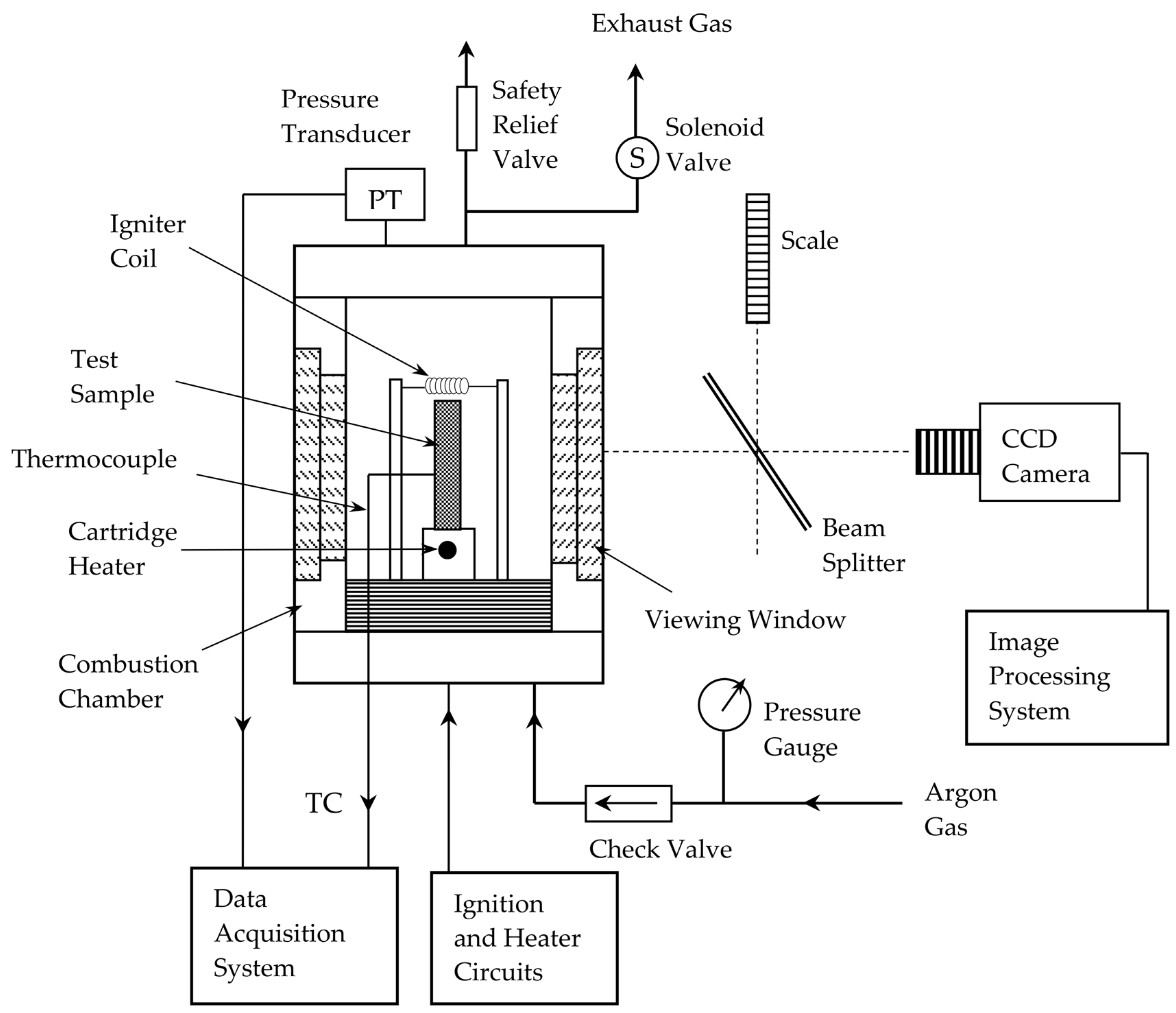
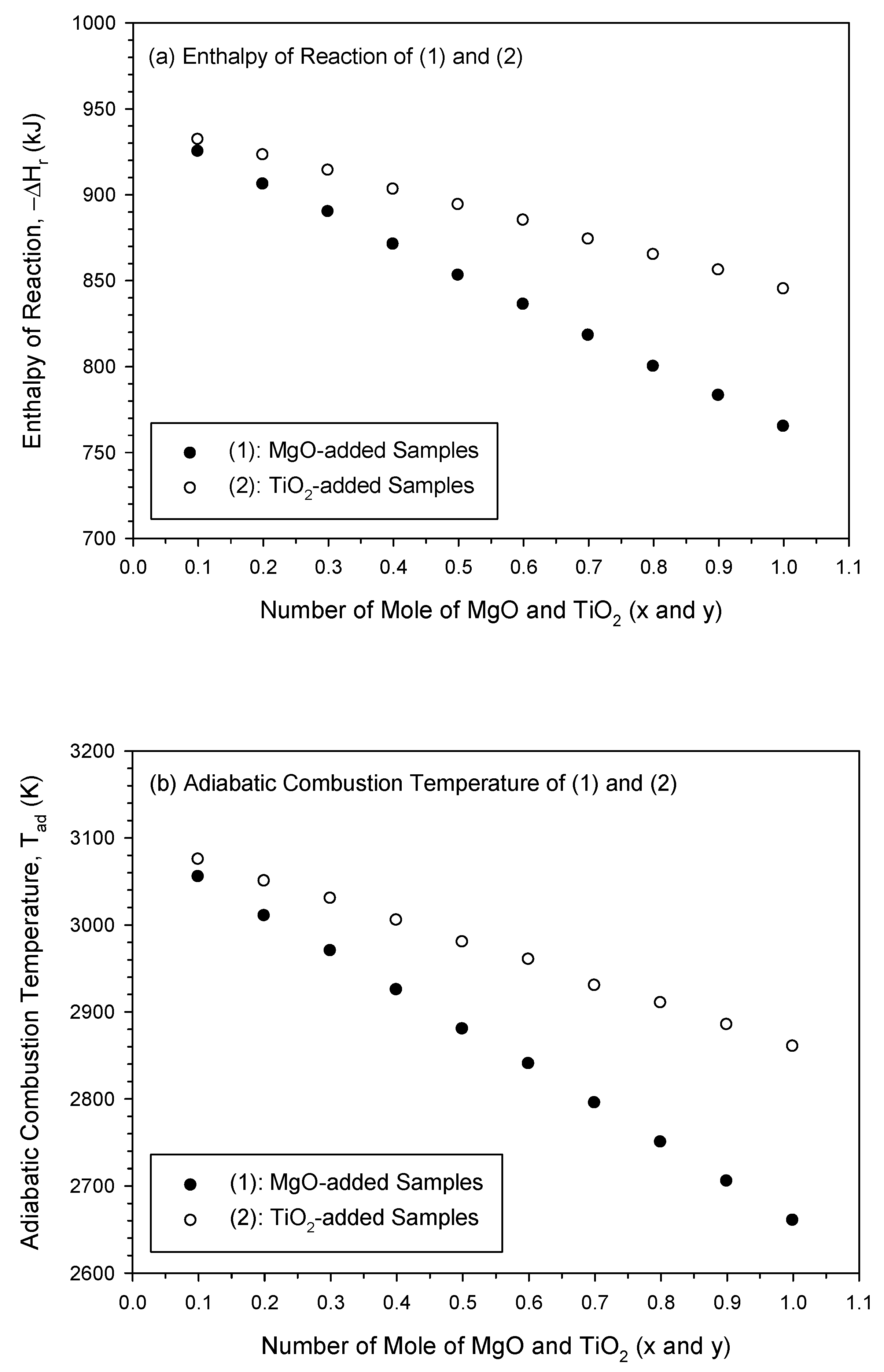

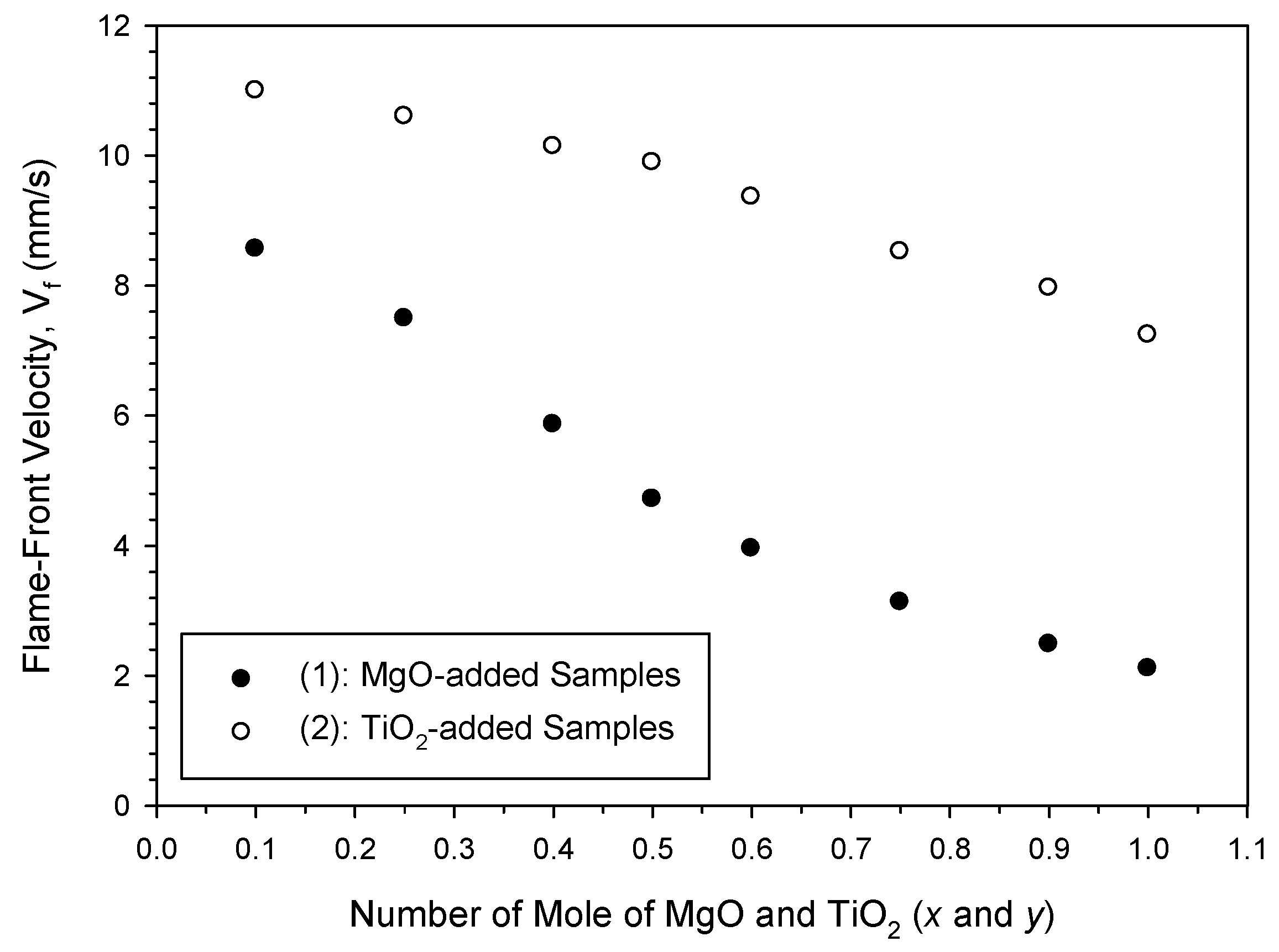

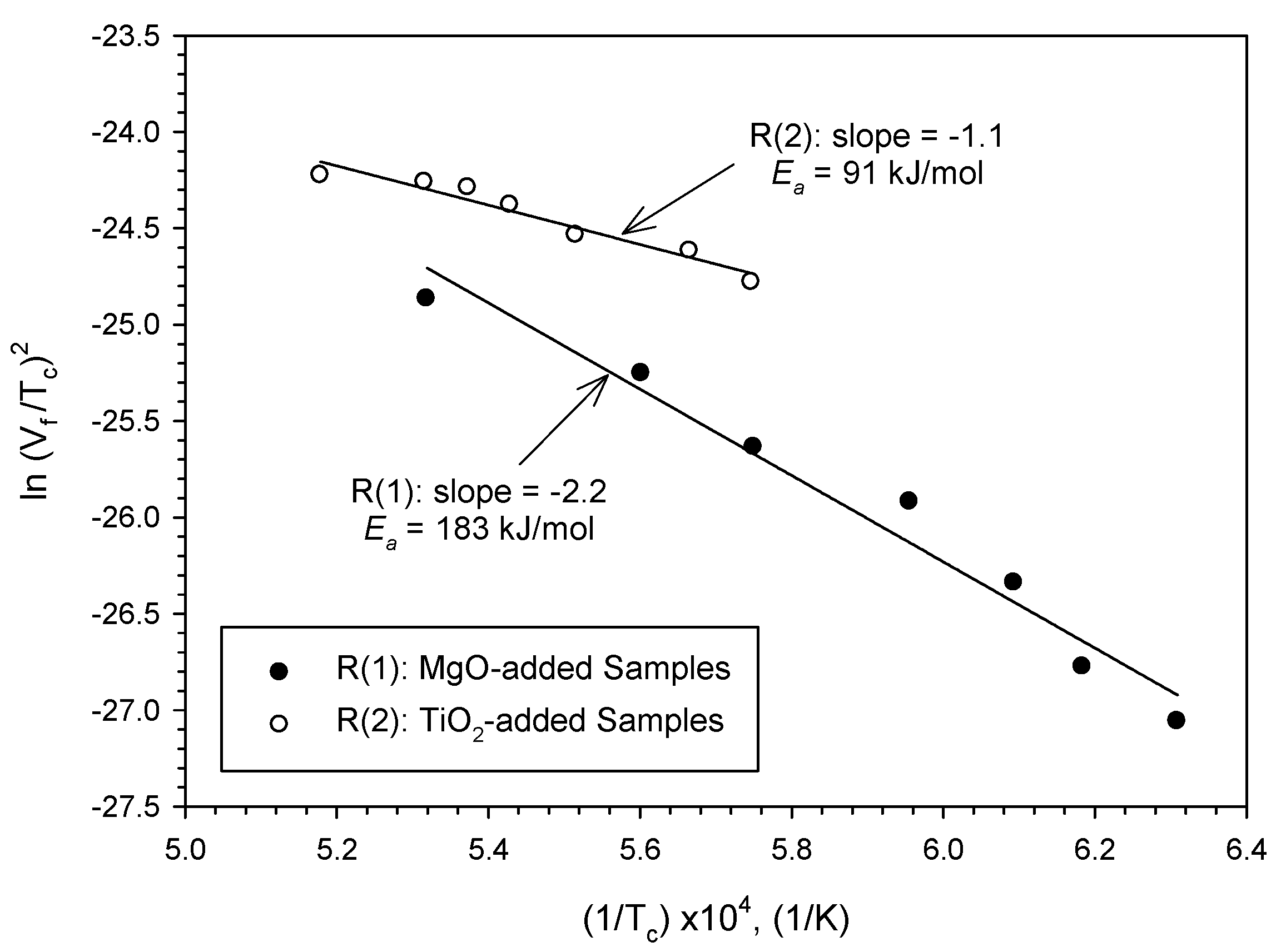
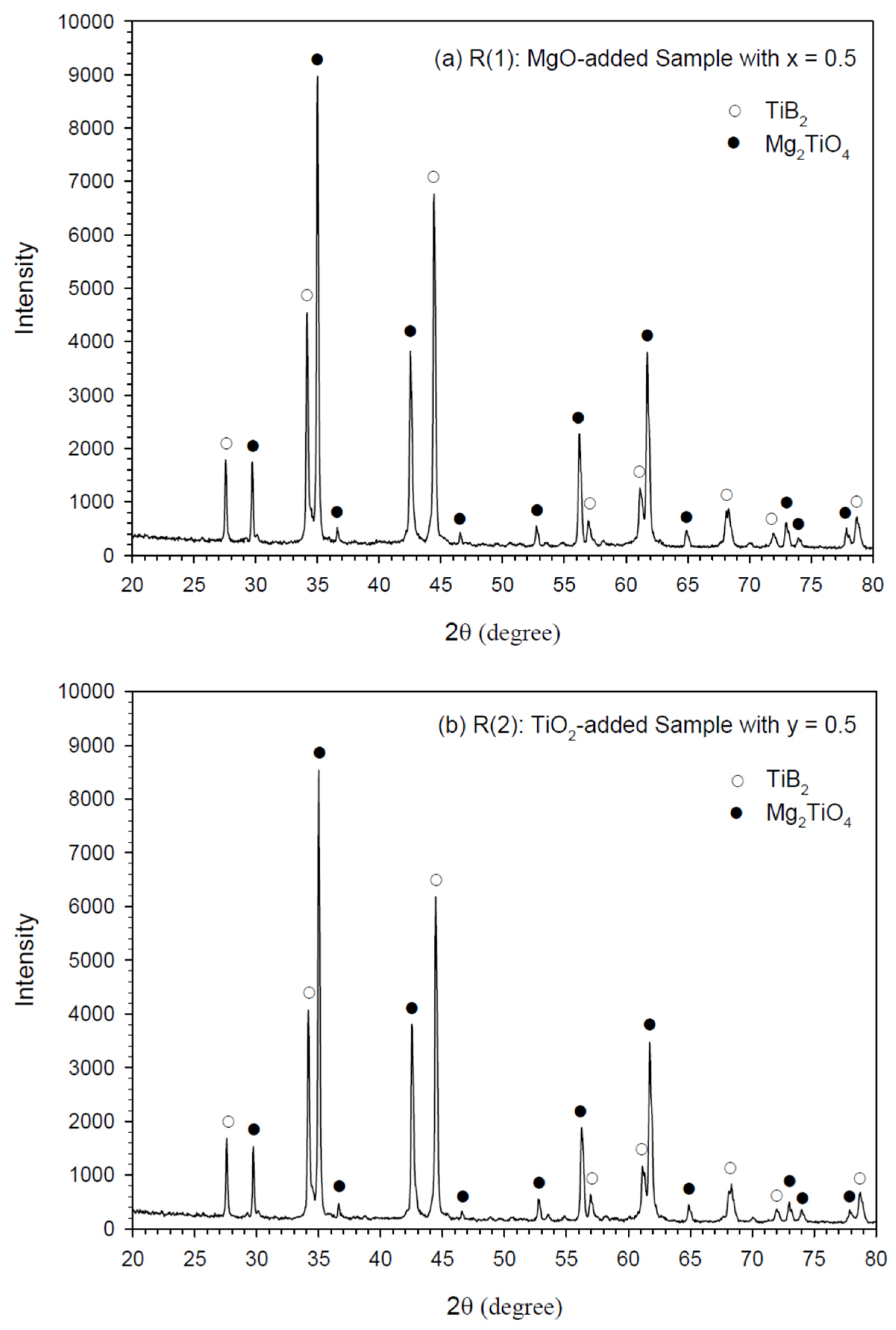
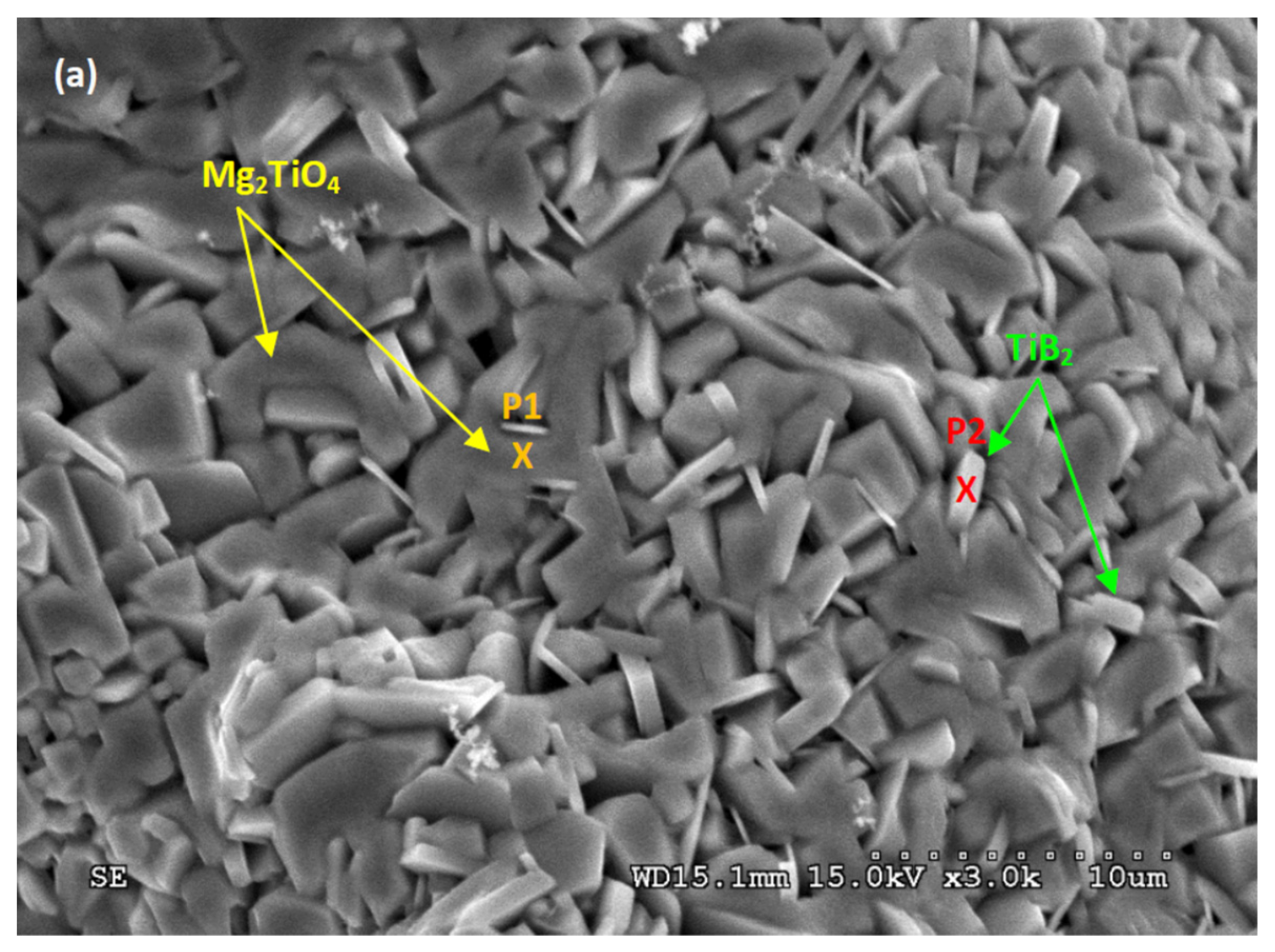

Disclaimer/Publisher’s Note: The statements, opinions and data contained in all publications are solely those of the individual author(s) and contributor(s) and not of MDPI and/or the editor(s). MDPI and/or the editor(s) disclaim responsibility for any injury to people or property resulting from any ideas, methods, instructions or products referred to in the content. |
© 2024 by the authors. Licensee MDPI, Basel, Switzerland. This article is an open access article distributed under the terms and conditions of the Creative Commons Attribution (CC BY) license (https://creativecommons.org/licenses/by/4.0/).
Share and Cite
Yeh, C.-L.; Chen, C. In Situ Formation of Titanium Diboride/Magnesium Titanate Composites by Magnesiothermic-Based Combustion Synthesis. Processes 2024, 12, 459. https://doi.org/10.3390/pr12030459
Yeh C-L, Chen C. In Situ Formation of Titanium Diboride/Magnesium Titanate Composites by Magnesiothermic-Based Combustion Synthesis. Processes. 2024; 12(3):459. https://doi.org/10.3390/pr12030459
Chicago/Turabian StyleYeh, Chun-Liang, and Chen Chen. 2024. "In Situ Formation of Titanium Diboride/Magnesium Titanate Composites by Magnesiothermic-Based Combustion Synthesis" Processes 12, no. 3: 459. https://doi.org/10.3390/pr12030459
APA StyleYeh, C.-L., & Chen, C. (2024). In Situ Formation of Titanium Diboride/Magnesium Titanate Composites by Magnesiothermic-Based Combustion Synthesis. Processes, 12(3), 459. https://doi.org/10.3390/pr12030459








